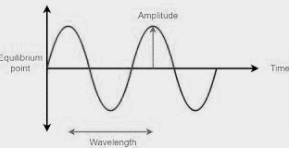In physics, sound is a vibration which travels through a transmission medium such as a gas, liquid, or solid as an acoustic wave. Sound is the absorption of such waves and the brain’s perception of them in human physiology and psychology.
Sound Vibration
A sound’s source vibrates, colliding with surrounding air molecules, which collide with their neighbours, and so on. This causes a wave of vibrations to flow through the air to the eardrum, which then vibrates as well.
Sound
We sense the vibrations in the air as we hear something. Our eardrums vibrate as a result of these vibrations entering the outer ear (or oscillate). The hammer, anvil, and stirrup are three small bones attached to the eardrum which also vibrate. Within the inner ear, these bones produce greater vibrations, effectively amplifying incoming vibrations before they are taken up by the auditory nerve.
When a sound wave travels through different media, such as gas (e.g. air), liquid (e.g. water), or solid (e.g. rock), its properties alter (e.g. bone). A wave travels quicker through a denser material than it does in a less dense medium. It means that sound travels faster via water than air, and bone travels faster than water.
As molecules vibrate in a medium, they can move up and down or back and forth. Sound energy forces molecules to oscillate back and forth in similar direction as the sound. A longitudinal wave is what it is called. (Transverse waves arise when molecules move up and down in a direction that is perpendicular to the wave’s travel direction.)
Vibrations are involved in both speaking and hearing. When we talk, we push air through our vocal cords, causing them to vibrate. Stretching our vocal chords allows us to vary the sounds we produce. We produce high sounds whenever the vocal cords are strained, and lower ones if they are loose. This is referred to as the sound’s pitch.
Types of Sound
There are many different types of sounds some are given here:
Infrasonic Waves (Infrasound)
The human ear cannot hear infrasonic waves since their frequencies are below 20 Hz. Infrasound is used by scientists to predict earthquakes and volcanic eruptions, to trace subterranean rock and petroleum formations, and to analyse heart activity. Unlike our inability to hear infrasound, many creatures interact in nature via infrasound waves. Infrasound is used by whales, hippos, rhinos, giraffes, elephants, and alligators to communicate across long distances – sometimes hundreds of kilometres.
Ultrasonic Waves (Ultrasound)
Ultrasound is created by sound waves with frequency greater than 20,000 Hz. Ultrasound is inaudible to the human ear because it operates at frequencies outside of the human hearing range. Ultrasound is widely used by medical specialists who use sonograms to examine their patients’ internal organs.
Vibration
Vibration is a mechanical phenomenon that causes oscillations around a fixed point. The word vibration originates from the Latin vibrationem (“shaking, brandishing”). Periodic oscillations, like a pendulum, or random oscillations, like those of a tyre on a gravel road, are possible. Vibrations from a tuning fork, a reed in a woodwind instrument or harp, a cell phone, or the cone of a loudspeaker can all be useful.
Vibration, on the other hand, is frequently unwanted, squandering energy and producing undesired noises. Engines, electric motors, and any other mechanical equipment in operation, for instance, produce unpleasant vibrations. Vibrations like these might be created by imbalances in spinning parts, unequal friction, or gear teeth meshing. Vibrations are frequently reduced through careful design.
The study of sound and vibration is intertwined. Vibrating structures (e.g. vocal chords) emit sound, or pressure waves; these pressure waves can also cause structures to vibrate (e.g. ear drum). As a result, efforts to reduce noise are frequently linked to vibration difficulties.
Sound vibration diagram
Types of vibration
Some types of Vibration are given below:
Free vibration
There is no externally applied vibration force in a free vibration. In most cases, the solution to a free vibration is nearly sinusoidal. Vibrations, of course, can arise at a wide range of frequencies.
Forced vibration
Forced vibration occurs whenever a mechanical system is subjected to a time-varying disturbance (load, displacement, velocity, or acceleration. The frequency of the steady-state vibration analysis resulting from the application of a periodic, harmonic input is equal to the frequency of the applied force or motion for linear systems, with the size of the response being dependent on the specific mechanical system.
Damped vibration
Vibrations are considered to be damped when the energy of a vibrating system is progressively absorbed by friction and other resistances. The system recovers to its original state of balance when the vibrations progressively diminish in frequency or severity, or stop completely. This form of vibration is represented by the automobile suspension, which is dampened by the shock absorber.
Conclusion
A sound’s source vibrates, colliding with surrounding air molecules, which collide with their neighbours, and so on. This causes a wave of vibrations to flow through the air to the eardrum, which then vibrates as well.
We sense the vibrations in the air as we hear something. Our eardrums vibrate as a result of these vibrations entering the outer ear (or oscillate). The hammer, anvil, and stirrup are three small bones attached to the eardrum which also vibrate. Within the inner ear, these bones produce greater vibrations, effectively amplifying incoming vibrations before they are taken up by the auditory nerve.
 Profile
Profile Settings
Settings Refer your friends
Refer your friends Sign out
Sign out







